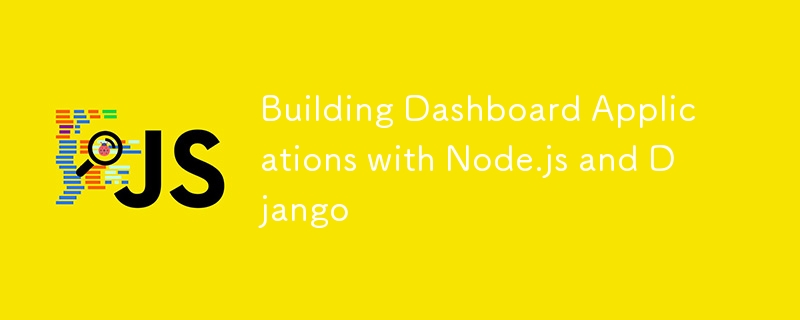
Pengenalan
Dalam dua minggu yang lalu, saya telah mendalami dua teknologi terkemuka yang digunakan untuk membina aplikasi papan pemuka: Node.js dan Django. Dokumentasi ini bertujuan untuk memberikan gambaran menyeluruh tentang rangka kerja ini, menyerlahkan ciri unik, kelebihan dan aplikasi praktikalnya. Node.js dan Django adalah kedua-dua rangka kerja yang teguh, masing-masing memenuhi keperluan dan keutamaan pembangunan yang berbeza.
Node.js untuk Aplikasi Papan Pemuka
Ikhtisar
Node.js ialah masa jalan JavaScript yang dibina pada enjin V8 Chrome yang membolehkan pembangun menjalankan JavaScript pada bahagian pelayan. Ia terkenal dengan seni bina yang tidak menyekat, dipacu peristiwa, yang menjadikannya sangat sesuai untuk aplikasi masa nyata.
Ciri Utama
- Pemprosesan Asynchronous: Node.js mengendalikan berbilang permintaan secara serentak tanpa menunggu setiap satu selesai. Ciri ini penting untuk papan pemuka masa nyata yang perlu memaparkan data langsung.
- Skalabiliti: Node.js direka bentuk untuk berskala, membolehkan pembangun membina aplikasi yang boleh mengendalikan bilangan pengguna dan data yang semakin meningkat.
- Ekosistem NPM: Node.js dilengkapi dengan perpustakaan pakej yang luas melalui npm (Pengurus Pakej Node), yang boleh digunakan untuk menyepadukan pelbagai fungsi ke dalam papan pemuka anda, seperti perpustakaan visualisasi data seperti Chart.js dan D3.js.
- Rangka Kerja Ekspres: Ekspres ialah rangka kerja aplikasi web Node.js yang minimum dan fleksibel yang menyediakan set ciri yang mantap untuk membangunkan aplikasi web dan mudah alih. Ia memudahkan penghalaan dan pengendalian permintaan HTTP, menjadikannya lebih mudah untuk membina bahagian belakang untuk papan pemuka.
Membina Papan Pemuka dengan Node.js
Untuk membina aplikasi papan pemuka menggunakan Node.js, ikut langkah berikut:
- Sediakan Node.js: Pasang Node.js dan sediakan direktori projek.
- Buat Pelayan: Gunakan Express untuk mencipta pelayan yang akan mengendalikan permintaan API dan menyediakan papan pemuka.
- Sepadukan Sumber Data: Sambung ke pangkalan data atau API luaran untuk mengambil data. Gunakan perpustakaan seperti Axios untuk permintaan HTTP.
- Bina Frontend: Bangunkan antara muka pengguna menggunakan HTML, CSS dan JavaScript. Sepadukan perpustakaan visualisasi data untuk memaparkan carta dan graf.
- Laksanakan Ciri Masa Nyata: Gunakan WebSockets atau perpustakaan seperti Socket.io untuk kemas kini data langsung.
Django untuk Aplikasi Papan Pemuka
Ikhtisar
Django ialah rangka kerja web Python peringkat tinggi yang menggalakkan pembangunan pesat dan reka bentuk yang bersih dan pragmatik. Ia mengikut falsafah "termasuk bateri", menyediakan banyak ciri terbina dalam untuk membantu pembangun membina aplikasi yang mantap dengan cepat.
Ciri Utama
- Antara Muka Pentadbir Terbina Dalam: Django hadir dengan antara muka pentadbir yang berkuasa yang membolehkan pengurusan mudah model data, yang berguna untuk mencipta dan mengurus data papan pemuka.
- ORM (Pemetaan Perkaitan Objek): ORM Django membenarkan pembangun berinteraksi dengan pangkalan data menggunakan objek Python dan bukannya pertanyaan SQL mentah. Ini memudahkan pengurusan dan penyepaduan data.
- Keselamatan: Django menyediakan ciri keselamatan yang kukuh di luar kotak, termasuk perlindungan terhadap kelemahan web biasa seperti CSRF, suntikan SQL dan XSS.
- Enjin Templat: Enjin templat Django membolehkan pembangun menjana halaman HTML secara dinamik, menjadikannya mudah untuk mencipta dan mengemas kini paparan papan pemuka.
Membina Papan Pemuka dengan Django
Untuk membina aplikasi papan pemuka menggunakan Django, ikut langkah berikut:
- Sediakan Django: Pasang Django dan mulakan projek baharu menggunakan alatan baris arahan Django.
- Tentukan Model: Gunakan ORM Django untuk mencipta model data yang mewakili maklumat yang dipaparkan pada papan pemuka anda.
- Buat Paparan: Bangunkan paparan yang memproses permintaan dan membalas respons. Gunakan paparan generik terbina dalam Django untuk memudahkan tugas biasa.
- Templat Reka Bentuk: Cipta templat HTML untuk reka letak papan pemuka dan sepadukan kandungan dinamik menggunakan bahasa templat Django.
- Laksanakan Visualisasi Data: Gunakan perpustakaan seperti Chart.js atau integrasikan pakej pihak ketiga untuk memaparkan data dalam carta dan graf.
Kesimpulan
Kedua-dua Node.js dan Django adalah pilihan terbaik untuk membina aplikasi papan pemuka, masing-masing dengan kekuatannya. Node.js cemerlang dalam mengendalikan kemas kini masa nyata dan operasi tak segerak, menjadikannya ideal untuk papan pemuka interaktif. Django, dengan ciri terbina dalam dan keselamatan yang teguh, sangat sesuai untuk aplikasi yang pembangunan pesat dan pengurusan data yang kukuh adalah keutamaan. Pilihan antara kedua-duanya bergantung pada keperluan projek khusus anda, bahasa pengaturcaraan pilihan dan jenis ciri yang anda perlukan.
Atas ialah kandungan terperinci Membina Aplikasi Papan Pemuka dengan Node.js dan Django. Untuk maklumat lanjut, sila ikut artikel berkaitan lain di laman web China PHP!






